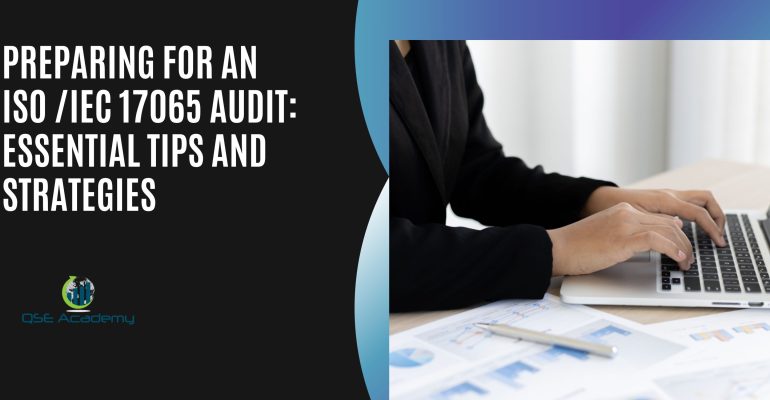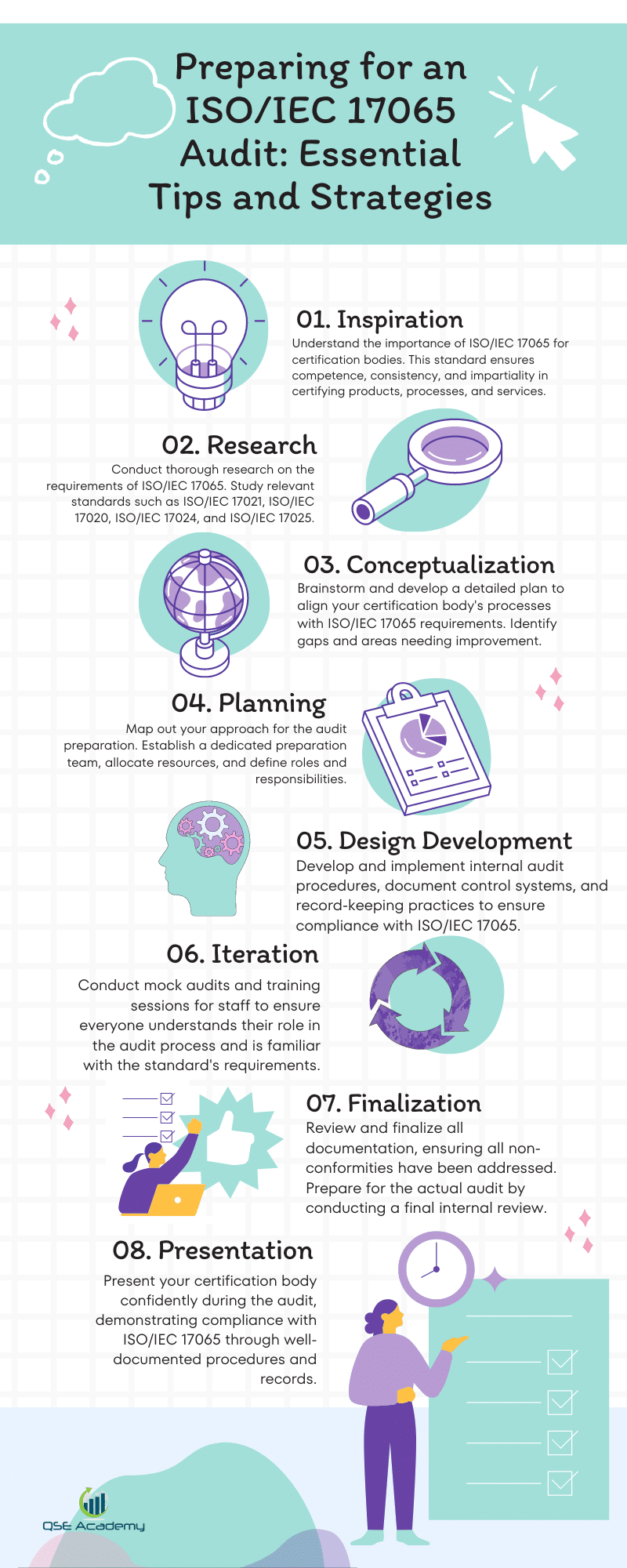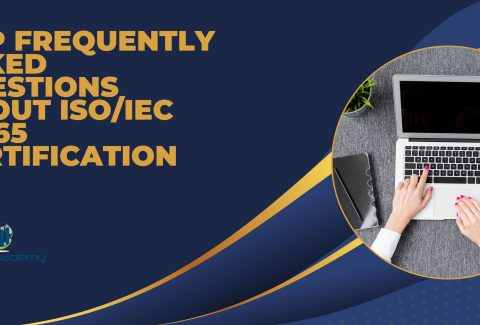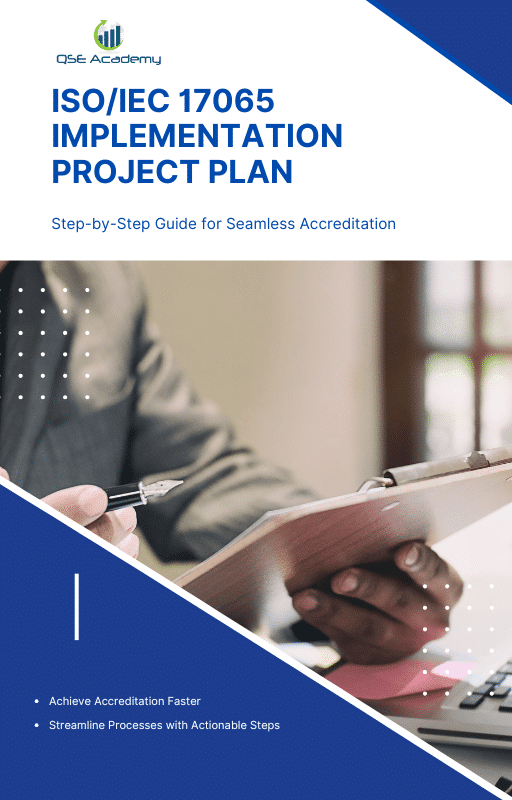Preparing for an ISO/IEC 17065 Audit: Essential Tips and Strategies
The prospect of an ISO/IEC 17065 audit often evokes a sense of daunting complexity. ISO/IEC 17065 sets the bar high for conformity assessment bodies, ensuring competence and impartiality. Preparing for the audit is a journey through a thicket of procedures, documentation, and systemic rigor. This article offers a roadmap, distilling the essential tips and strategies to navigate the preparation for an ISO/IEC 17065 audit successfully.
Einführung
ISO/IEC 17065, titled “Requirements for bodies certifying products, processes, and services,” is a crucial international standard that describes the requirements for a body certifying products, including processes and services. It ensures competence, consistency, and impartiality in the operations of these organizations. The significance of ISO/IEC 17065 lies in its role as a benchmark for the performance of certification bodies. By adhering to this standard, certification bodies demonstrate their ability to reliably certify products, processes, or services, in turn providing assurance to stakeholders and consumers regarding the quality and safety of certified items.
Regular audits are instrumental in maintaining compliance with ISO/IEC 17065 and preserving the integrity of certifications. These audits provide an opportunity for continuous improvement and help to sustain trust in the certification process. The evolution of ISO/IEC 17065 audits has seen the standard become more comprehensive, aligning with other conformity assessment standards like ISO/IEC 17020 (for inspection bodies) and ISO/IEC 17021 (for management systems certifications), ensuring a cohesive approach to certification activities.
Sector Standard Relevant to Compliance:
- ISO/IEC 17020: Inspection Bodies
- ISO/IEC 17021: Management Systems Certification Bodies
- ISO/IEC 17024: Personnel Certification Bodies
- ISO/IEC 17025: Testing and Calibration Laboratories
- ISO/IEC 17065: Product, Process, and Service Certification Bodies
By continuously updating and refining its criteria, ISO/IEC 17065 audit processes maintain their relevance and efficacy in verifying that certification bodies operate at the highest standard.
Understanding the Audit Process
Audit Types
| Interne Audits | Externe Audits | Überwachungsaudits |
| Focus on self-evaluation by the certification body. | Performed by external bodies such as accreditation organizations. | Conducted periodically to ensure continued compliance after initial certification. |
The purpose of an ISO/IEC 17065 audit is multifaceted:
- It seeks to ensure compliance with specific international standards and management system requirements as outlined in ISO/IEC 17065:2012.
- The audit process is designed to identify areas that need improvement within a certification body’s operational procedures and certification activities.
- An important objective is to validate the effectiveness of processes the certification body uses to issue certifications to clients against applicable standards such as ISO/IEC 17020, ISO/IEC 17024, ISO/IEC 17025, and others within its scope.
Audit Scope and Criteria
Defining the scope of an audit involves detailing the extent and boundaries of the audit process. It typically includes the inspection of:
- Structural requirements: Ensuring the certification body has the appropriate organizational structure.
- Resource requirements: Examining the availability and management of necessary resources.
- Process requirements: Analyzing the procedures for certification schemes and making certification decisions.
- Management system requirements: Assessing the effectiveness of the quality management system including review processes and corrective actions.
Each of these components is critical in ensuring that the certification body operates in compliance with ISO/IEC 17065, providing reliable and professional service certification.
Preparation Steps for the Audit
Durchführen einer Lückenanalyse To lay a solid foundation for the ISO/IEC 17065 audit, start with a thorough gap analysis. This process involves identifying the differences between your current practices and the stringent requirements of the ISO/IEC 17065 international standard. To carry out an effective gap analysis:
- Review the ISO/IEC 17065:2012 criteria concerning your certification body’s procedures.
- Match your existing processes against the standard to pinpoint discrepancies.
- Document the findings to develop a clear action plan for addressing gaps.
Establishing a Preparation Team Effective audits begin with a cohesive audit preparation team. Inclusion of top management is crucial to signal the importance of the audit across the organization. The team should have distinct roles, such as:
- Project Manager: Leading the preparation and ensuring all deadlines are met.
- Internal Auditor(s): Assessing internal practices and offering improvement suggestions.
- Qualitätsmanager: Overseeing compliance with quality management system requirements.
- Technical Expert(s): Providing insights on the technical aspects of certification activities.
Ressourcen-Zuweisung Securing the necessary resources is critical for a successful ISO/IEC 17065 audit. Resource planning should encompass:
- A defined budget to cover the costs of audit preparation and execution.
- Adequate infrastructure and technological supports to meet the conformity assessment body’s needs.
- Allocation of personnel to support the auditing process and implement corrective actions as needed.
Dokumentation und Aufzeichnungen
Maintaining Accurate Records For a certification body gearing up for an ISO/IEC 17065 audit, meticulous documentation and record-keeping are critical. The array of required records includes internal audit reports, corrective actions, record of certification decisions, and records related to complaints and appeals. Effective audits hinge on accurate Internal Audit Records that provide evidence of conformity with both management system requirements and product/service certification schemes.
Document Control Systems A robust document control system is central to ensuring that all necessary records are organized, accessible and protected from unauthorized changes or loss. This system must be capable of handling various document iterations, upholding the integrity of the management review process, and preserving the confidentiality of the certification activities.
Review and Update Documentation Continuous improvement calls for regular reviews and updates of all documentation governing certification processes and procedures. Every piece of documentation, be it related to structural requirements, Process requirements, or applicable standards, must be assessed on a set schedule. This ensures ongoing compliance and preparedness for both internal audits and external evaluations by ISO/IEC 17065:2012 standards.
Incorporating these facets into your Certification body’s regimen ensures not only compliance but also a commitment to quality and excellence in the certification services offered.
Schulung und Sensibilisierung
Staff Training Programs
To prepare for an ISO/IEC 17065 audit, developing effective staff training programs is crucial. Such programs aim to assess and ensure that all staff members are competent and familiar with the certification body’s processes and the relevant international standards, including ISO/IEC 17065:2012. By building a comprehensive understanding, staff can more effectively engage in the audit process and contribute to continuous improvement.
Building Audit Awareness
Audit awareness is integral to the preparation phase. Conducting awareness sessions for all personnel helps underline the importance of understanding both the audit processes and the objectives. This knowledge is fundamental for the successful maintenance of the certification body’s compliance with ISO/IEC 17065 and other applicable standards such as ISO/IEC 17021, ISO/IEC 17020, and ISO/IEC 17024.
| Awareness Topics | Zweck |
| Audit Objectives | To clarify why the audit is conducted and what it aims to achieve |
| Prozess-Anforderungen | To ensure staff know what is expected in their roles during the audit |
| Strukturelle Anforderungen | To familiarize staff with the organizational framework being evaluated |
Simulated Audits and Drills
Implementing mock audits presents a hands-on opportunity for staff to experience the auditing process in a controlled environment. Learning from simulated audit findings and incorporating feedback is essential for identifying potential areas for corrective actions. These drills contribute significantly to the readiness of the organization for the actual audit process, promoting a culture that values preparedness and quality management.
Durchführung des Audits
When conducting an audit for certification bodies in line with ISO/IEC 17065, it is vital to adhere to a set of clearly defined procedures. The ISO/IEC 17065 audit process involves several crucial steps to ensure thorough examination and verification of a body’s conformance to the standard.
Initial Audit Meeting
Prior to delving into the audit’s substantive activities, an opening meeting is critical. This session sets the stage for a structured audit process. The audit team should communicate the scope, objectives, and expected outcomes, ensuring all parties are aligned. The meeting should also serve as an opportunity to introduce the audit team members and main contacts of the organization being audited, fostering a professional working relationship.
Audit Execution
The audit itself should be conducted methodically, examining the certification body’s adherence to applicable standards, including management system requirements, structural requirements, and process requirements. It is essential to maintain an air of cooperation and transparency to ensure effective audits. Auditors should meticulously follow the audit checklist, encouraging open communication and the use of audit questions designed to probe the depth of the organization’s practices.
Closing Meeting and Reporting
At the conclusion of the audit, a closing meeting is convened to discuss the findings. This includes reviewing both positive aspects of the certification process and any non-conformities that require corrective actions. Auditors provide initial feedback, paving the way for details to be elaborated in the final audit report that will influence the certification decision. Typically, this juncture serves as an impetus for continuous improvement within the certification body.
Post-Audit Actions
Umgang mit Nichtkonformitäten:
Once non-conformities are identified during an ISO/IEC 17065 audit, it’s crucial to address them systematically:
- Develop Corrective Action Plans: Each non-conformity should have a corresponding plan that details steps for resolution, responsible parties, and deadlines.
- Implementing Actions: Execute the corrective actions as per the plan.
- Tracking Corrective Actions: Keep an Internal Audit Record of the changes made and document evidence of compliance.
Use the following list to ensure efficient tracking:
- Action item
- Responsible individual
- Due date
- Status
- Evidence of completion
Ständige Verbesserung:
The goal is to use the audit findings for ongoing enhancement:
- Drive Improvement: Each finding should be viewed as an opportunity for improvement, analyzing the cause, and developing strategies to strengthen the certification body’s processes.
- Monitor Improvements: Regularly check the effectiveness of implemented changes to ensure they are providing the intended benefits.
- Evaluate Effectiveness: During management reviews, assess whether the improvements meet the certification schemes’ requirements and consider further actions for optimization.
Commitment to continuous improvement and addressing the audit’s outcomes are vital for maintaining the integrity and trust in the certification activities of a conformity assessment body per ISO/IEC 17065. These steps contribute to an effective audit process and ultimately enhance the quality of service certification.
Gemeinsame Herausforderungen und Lösungen
Managing Impartiality and Conflicts of Interest
One pressing issue in the ISO/IEC 17065 audit process involves maintaining impartiality and effectively handling conflicts of interest. To ensure fair and unbiased audit outcomes, it’s crucial for Certification Bodies to develop and implement clear strategies. This might include:
- Establishing robust conflict-of-interest policies.
- Routing regular reviews to detect potential impartiality issues.
- Training auditors to recognize and report potential conflicts promptly.
The ability to manage these aspects successfully sustains the integrity of the certification process and enhances the credibility of the Certification Body.
Ensuring Consistent and Fair Certification Decisions
Another recurring challenge is ensuring that certification decisions are consistent and fair regardless of the entity being assessed. This requires:
- A standardized set of decision-making criteria that is rigorously applied across all cases.
- Extensive records of past decisions to establish precedents and aid in maintaining uniformity.
Consistency in the application of these standards assures stakeholders that all certified entities comply with the applicable international norms and regulations, which is essential for building trust in certified products and services.
Fallstudien und bewährte Praktiken
Case Study 1: Successful Audit Preparation in a Manufacturing Certification Body
A manufacturing certification body aiming to comply with ISO/IEC 17065:2012 implemented a meticulous preparation process. The entity established an internal audit team, trained in ISO/IEC 17021 requirements, to conduct an initial review against a comprehensive audit checklist. Key challenges included aligning process requirements with International Standards and addressing gaps in the existing quality management system. To overcome these, they meticulously mapped out all management system requirements and executed corrective actions prior to the audit.
Short-term impacts were observed in the streamlined documentation and Internal Audit Records, while the long-term impact was a notable enhancement in the certification decision process, embedding continuous improvement as a core organizational value.
Case Study 2: Successful Audit Preparation in a Service-Based Certification Body
For a service certification entity, the preparation for ISO/IEC 17065 audit was challenging due to the intangible nature of their service offerings. Their focus was on tightening structural requirements and ensuring robust management review protocols. Solutions included extensive staff training and mock audits to practice effective audit questions. Post-audit results displayed improved compliance with applicable standards, reinforcing the certification schemes’ credibility.
This approach brought about improved audit process proficiency and a higher standard of certification activities, leading to elevated trust among stakeholders and enhanced reputation for quality assurance in the service sector.
Schlussfolgerung
In the landscape of conformity assessment, ISO/IEC 17065 represents a critical standard for certification bodies involved in the certification of products, processes, and services. The importance of ISO/IEC 17065 compliance cannot be overstated, as it not only enhances the credibility of certification activities but also facilitates international trade and market access.
The successful audit preparation hinges on a thorough understanding of the standard’s requirements, including its management system requirements, structural requirements, resource requirements, and the different types of process requirements. An effective audit process involves a well-maintained management review system, impeccable Internal Audit Records, and the implementation of corrective actions where necessary.
With the ever-evolving nature of international standards like ISO/IEC 17065, becoming complacent can be costly. Therefore, a continued commitment to compliance and continuous improvement is paramount for any certification body. Looking to the future, trends may lean towards more stringent scrutiny of certification schemes, heightened expectations for quality management within certification decision processes, and increasing integration with other relevant standards such as ISO/IEC 17020, ISO/IEC 17021, ISO/IEC 17024, and ISO/IEC 17025.
For bodies certifying products, services, or systems, staying ahead in the demanding field of conformity assessment will require a proactive stance on adhering to applicable standards, with an unflagging quest for excellence and improvement.
Referenzen
When preparing for an ISO/IEC 17065 audit, having access to reliable and authoritative sources is essential for understanding the requirements and implementing them effectively. Key references include:
- ISO/IEAC 17065:2012: This is the primary document outlining the requirements for bodies certifying products, processes, and services. It specifies criteria for a certification body’s structure, operations, and competence.
- ISO/IEC 17021: Offers guidance for bodies providing audit and certification of management systems. While focused on management systems, many of its principles are applicable to product certification bodies in maintaining their own systems.
- ISO/IEC 17020: This standard gives the criteria for the operation of various types of bodies performing inspections and can be complementary to ISO/IEC 17065 for bodies that do both certification and inspection.
- ISO/IEC 17025: Provides general requirements for the competence of testing and calibration laboratories which can be relevant for certification bodies that also offer these services.
- ISO/IEC 17024: Establishes the requirements for certifying individuals, which may be useful for certifying bodies that wish to ensure the competence of their own staff.
- Applicable Standards for Specific Certification Schemes: Certification bodies must also be familiar with the specific standards and guidelines relevant to the products, processes, or services they are certifying.
For the most comprehensive and current information, it is recommended to access these documents through the official International Organization for Standardization (ISO) website or through recognized national standards bodies. Additionally, industry guidelines and best practices can be found in publications from sector-specific professional associations and industry groups that are engaged with certification activities and continuous improvement practices.
Table: Essential References for ISO/IEC 17065 Audit Preparation
| Dokument | Beschreibung |
| ISO/IEC 17065:2012 | Core standard for product certification bodies |
| ISO/IEC 17021 | Guideline for certification of management systems |
| ISO/IEC 17020 | Requirements for the operation of inspection bodies |
| ISO/IEC 17025 | Competence of testing and calibration laboratories |
| ISO/IEC 17024 | Certifying individuals – personnel certification |
| Certification Scheme Standards | Specific standards for products, processes, or services |
For more details and updated versions, visit the official ISO website or contact your national standards body.
Anhang
For effective audits under the ISO/IEC 17065:2012, which sets the requirements for bodies certifying products, processes, and services, it is essential to approach the auditing process systematically. To assist Certification Bodies in adherence to international standard prerequisites and to streamline their audit preparations, several additional resources and tools are accessible.
Vorlagen und Checklisten:
- Internal Audit Checklist: A detailed guide to ensure all ISO/IEC 17065 requirements are reviewed.
- Management Review Template: Facilitates the process of evaluating management system requirements.
- Corrective Actions Log: Helps track and implement necessary corrective actions efficiently.
Schulungs- und Zertifizierungsprogramme:
- Internal Auditor Training: Provides necessary skills for conducting internal audits and implementing ISO/IEC 17065.
- Certification Body Training: Enhances understanding of structural requirements, process requirements, and certification decision processes associated with ISO/IEC 17065.
Use these tools to prepare for the ISO/IEC 17065 audit process effectively and ensure continuous improvement in certification activities. Remember, preparation and attention to detail are key components of a successful certification process and service certification.
Suchen Sie weitere Ressourcen zur ISO 17065?
Wenn Sie diesen Artikel als hilfreich empfunden haben, sollten Sie sich unsere Premium-Ressourcen ansehen, die Ihnen helfen, die ISO 9001-Zertifizierung effizient zu erreichen:
- 📦 Vollständiges Dokumentationspaket für ISO/IEC 17065 2012: Sie erhalten alle wichtigen Vorlagen und Dokumente, die Sie für eine schnelle und einfache Umsetzung benötigen.
- 🎓 Online-Kurs zur ISO/IEC 17065 2012 : Nehmen Sie an unserer umfassenden Schulung teil, um die wichtigsten Konzepte und praktischen Schritte zur Zertifizierung zu erlernen.
- 📋 ISO/IEC 17065 2012 Prüfliste: Laden Sie unsere detaillierte Checkliste herunter, um sicherzustellen, dass Sie jeden Schritt des Prozesses berücksichtigt haben.
Diese Ressourcen sind auf Ihre Bedürfnisse zugeschnitten und gewährleisten einen reibungslosen Ablauf der Zertifizierung. Entdecken Sie sie noch heute und kommen Sie Ihrem Erfolg einen Schritt näher!














